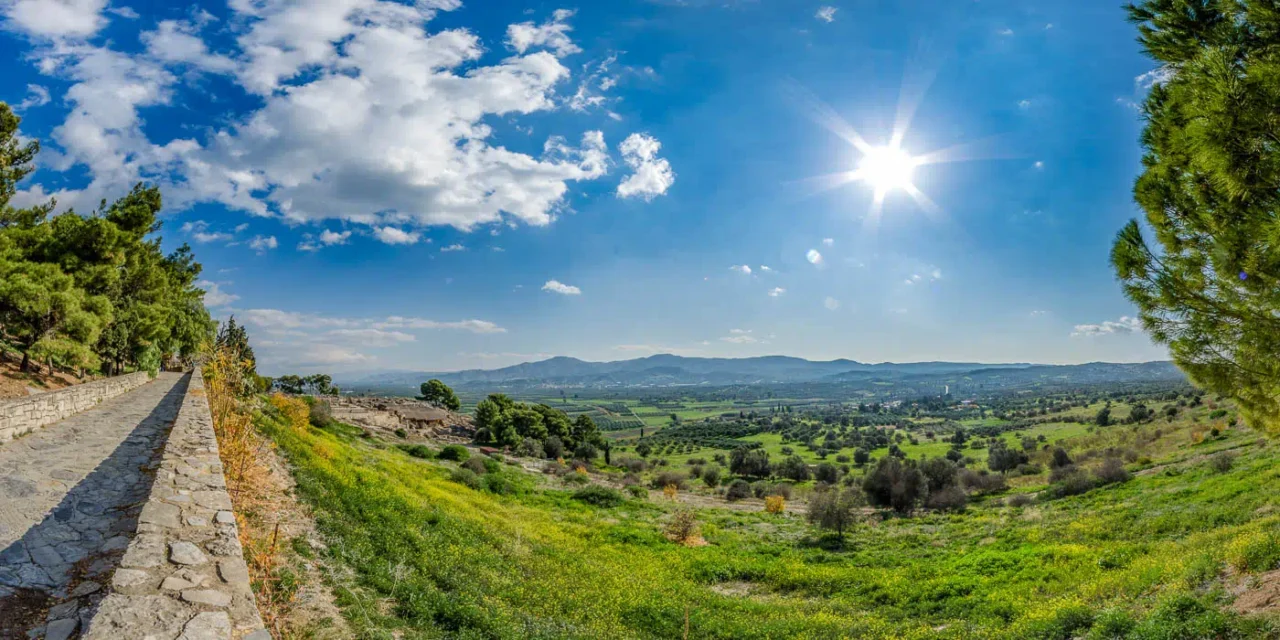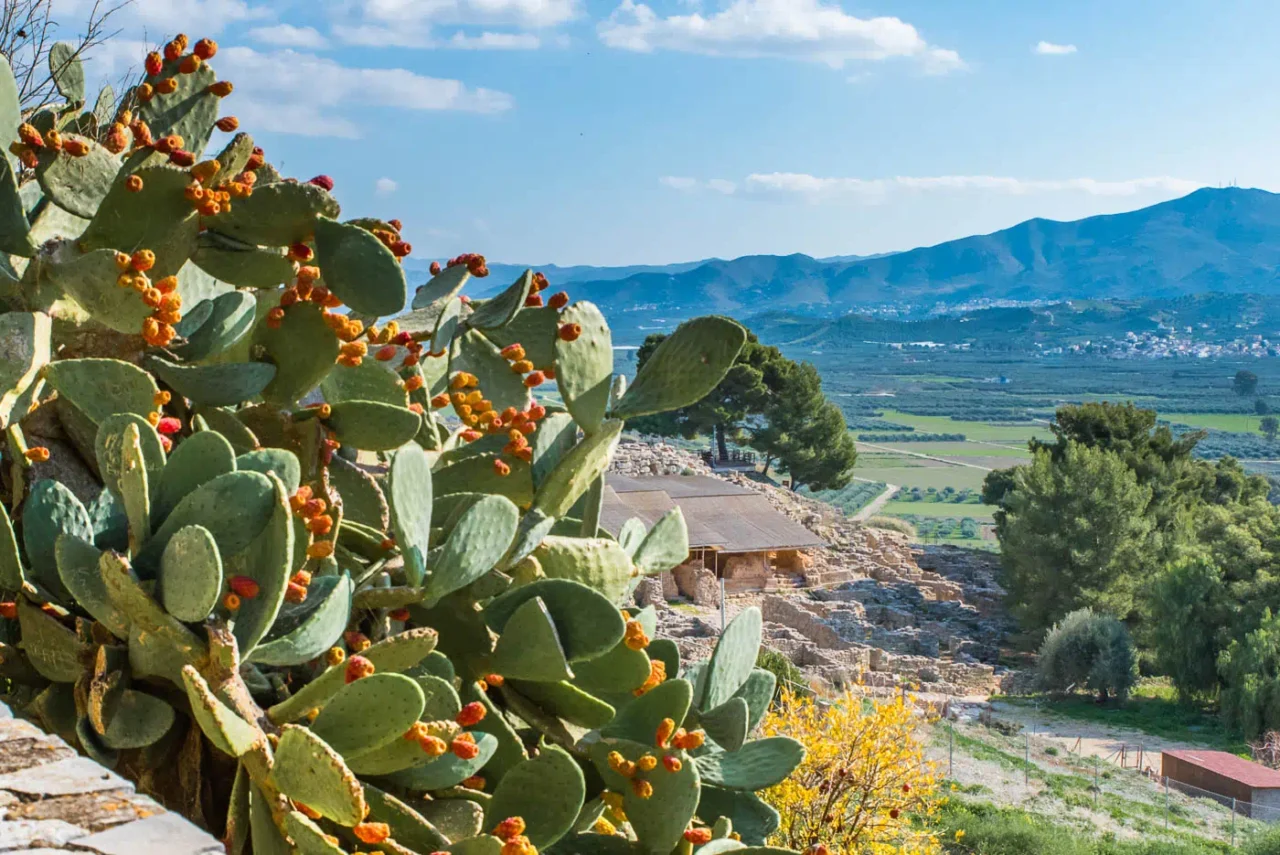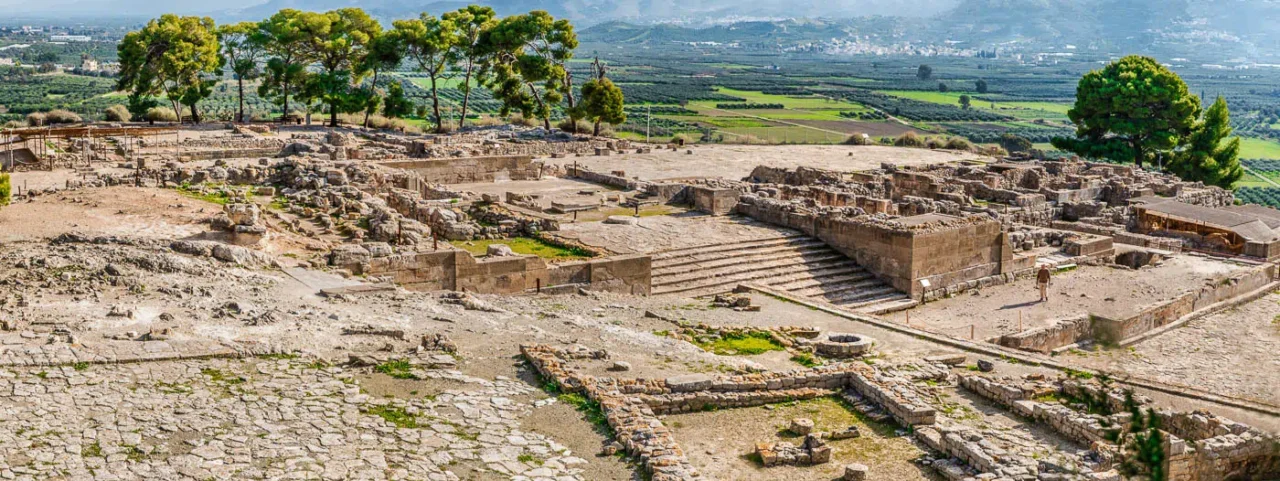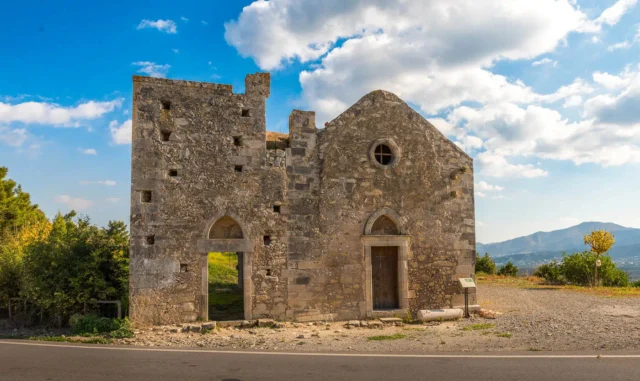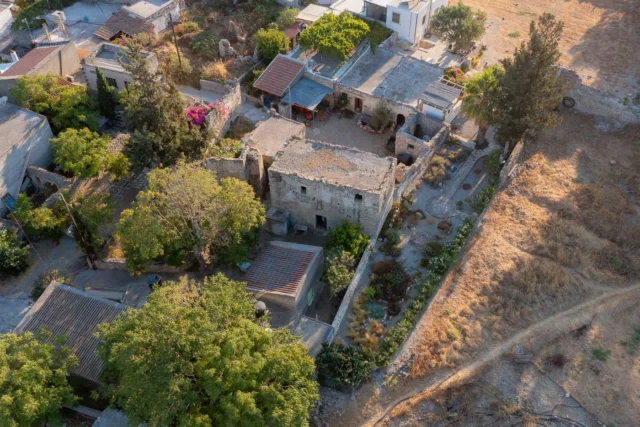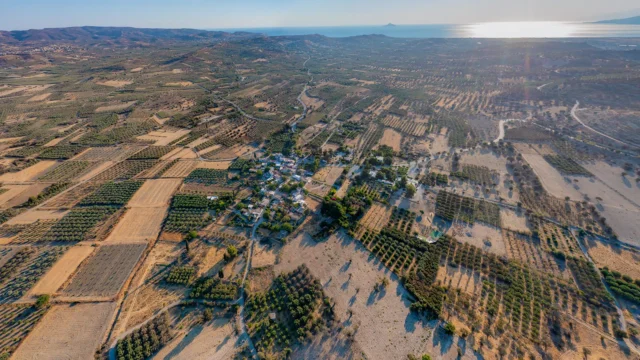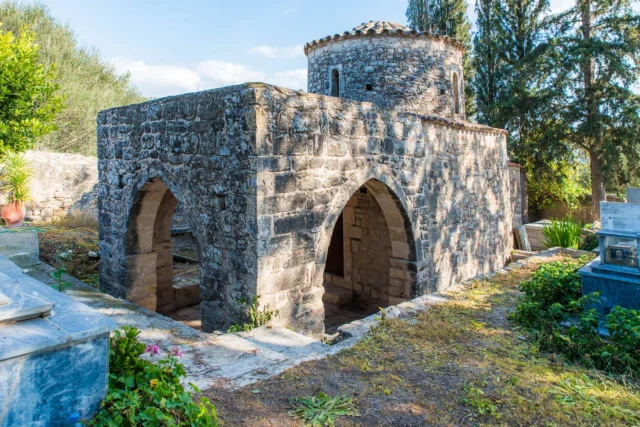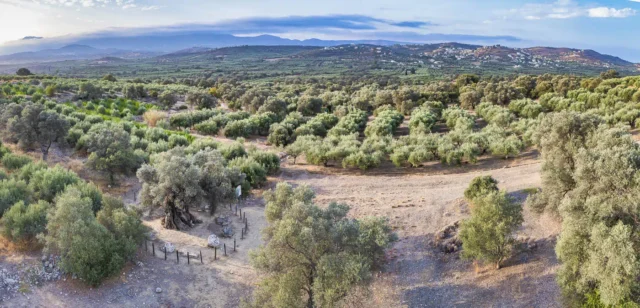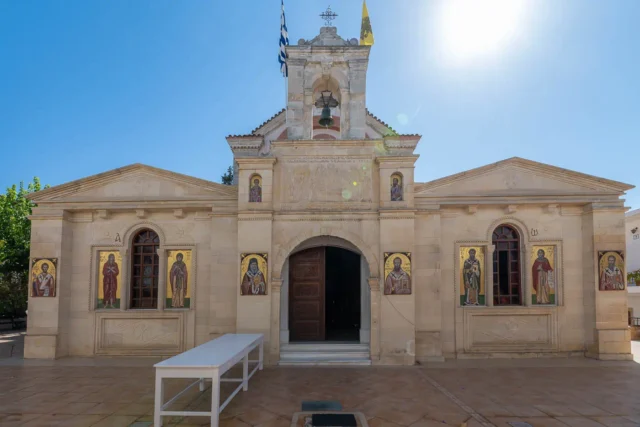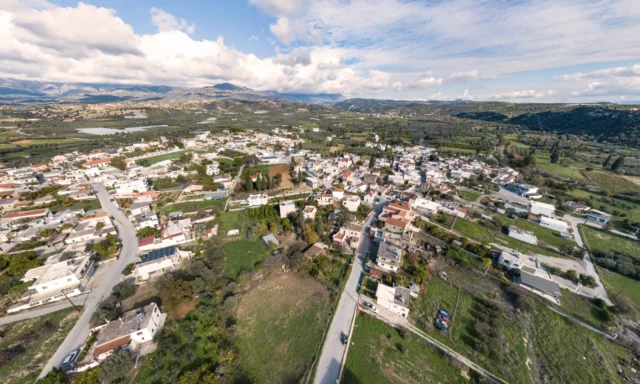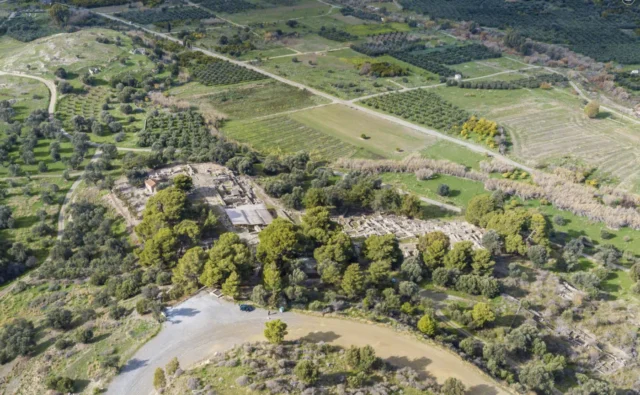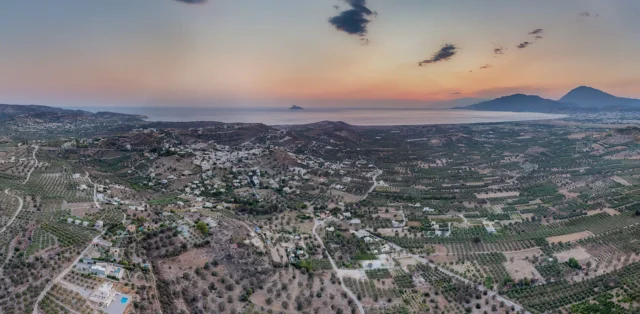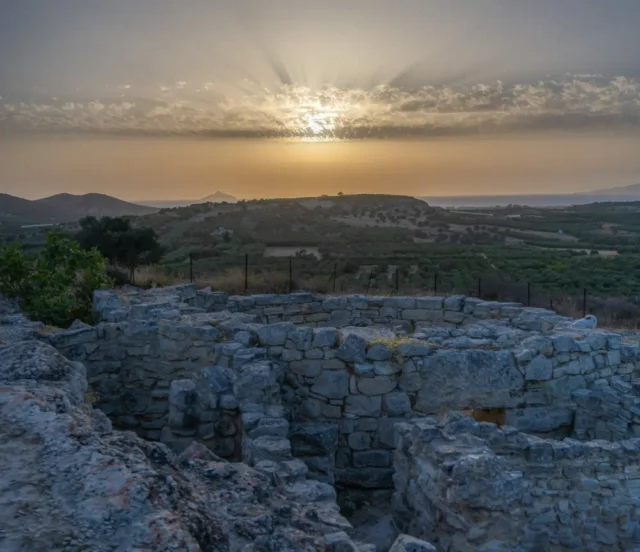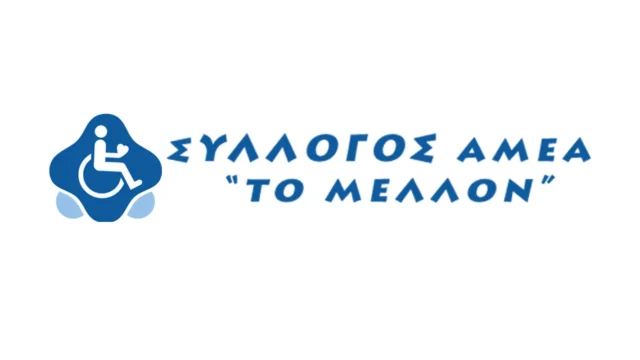Location: The palace of Phaistos is located in the southern part of Crete. The site is situated in the Western Messara Plain.
Phaistos is a significant archaeological site in Crete with evidence of settlement from the Neolithic period through Hellenistic and later times. It is known for its palace, one of the major Minoan centers, and for later urban development in the Hellenistic period. Archaeological investigations, including excavations and surveys, have revealed much about its history, architecture, and cultural significance.
Historical Periods
Neolithic Period
Evidence from archaeological investigations indicates a Final Neolithic settlement at Phaistos, which was contemporary with the later phases of the Neolithic period at Knossos. Two distinct occupation phases have been identified, broadly corresponding to FN III and FN IV. During this period, Phaistos appears to have been the largest settlement within the Western Mesara. Notably, the archaeological record suggests that communal ceremonial activities took place at Phaistos during the Final Neolithic, involving a specialized set of pouring and drinking vessels.
Minoan Period
Prepalatial Period
Before the emergence of the first palace, Phaistos was a site of craft production and various social practices, as suggested by archaeological findings.
Protopalatial Period: The first palace at Phaistos was constructed during the Protopalatial period, around the beginning of the Middle Minoan period. More specifically, this construction occurred during MM IB-II. This initial palatial structure, indicative of Phaistos‘ growing importance, was later destroyed by a severe earthquake in approximately 1700 or 1650 BCE. During this time, Phaistos functioned as a significant center, evidenced by its monumental architecture and a complex written administrative system for managing resources.
Neopalatial Period
Following the destruction of the Old Palace, a new palace was erected at Phaistos during the Neopalatial period, specifically after the earthquake in Middle Minoan II. This reconstruction underscores the continued administrative significance of Phaistos, which persisted until its eventual destruction in Late Minoan IB. The period of Middle Minoan III (MM IIIA) is recognized as a transitional phase following earlier damage in MM IIB. While pottery production showed continuity, shifts in the control of this production are evident. Despite initial reconstruction efforts, the palace at Phaistos was likely not fully restored during MM IIIA. The nearby site of Agia Triada may have served as a secondary center, possibly a summer residence or an official seat for the rulers of Phaistos after the palace sustained damage.
Late Minoan Period (ca. 1600–1100 BCE)
Phaistos, along with most of Crete, experienced widespread destruction around 1450 BC, marking the end of Late Minoan IB. Notably, Knossos was the only major palatial center to survive this event. Despite this destruction, archaeological evidence indicates continued habitation at Phaistos during various phases of the Late Minoan period, including LM II, LM IIIA, LM IIIB, and LM IIIC. Similarly, Agia Triada was also resettled during the Late Minoan III or Mycenaean period. During Late Minoan I, Phaistos, Agia Triada, and Kommos appear to have fulfilled distinct and possibly complementary roles within the region.
Postpalatial Period (ca. 1450–1100 BCE)
In the aftermath of the widespread destruction around 1450 BCE, Knossos maintained its importance as a Minoan center until approximately 1375-1350 BCE (LM IIIA/B). During the LM IIIA2-B period (ca. 1375-1200 BCE), the Western Mesara witnessed a potential increase in population. However, Phaistos itself appears to have become a smaller settlement, primarily consisting of smaller houses, while a significant architectural complex was constructed at Agia Triada. The site of Kommos experienced a period of prosperity after the collapse of the palaces. Building P at Kommos emerged as an important administrative center, potentially under the influence of Knossos, which might have lessened the relative importance of Phaistos. By the Late Minoan IIIC period (ca. 1200-1000 BCE), the rural areas surrounding Phaistos seem to have been largely abandoned, possibly indicating a centralization of population at Phaistos itself.
Geometric, Archaic, and Classical Periods (ca. 1000–325 BCE)
Following a period of earlier activity, Phaistos experienced a resurgence during the Protogeometric-Geometric period (ca. 1000-725 BCE), evolving into a substantial fortified settlement. The subsequent Archaic period (ca. 725-500 BCE) witnessed the establishment of numerous settlements in the surrounding area, some of notable size, which clustered around Phaistos, indicating its continued dominance within the region. This settlement pattern suggests a potential expansion from the central site of Phaistos. By the Classical period (ca. 500-325 BC), Phaistos had developed into a polis, marked by a further increase in the number of settlement sites located outside the main urban center. Archaeological evidence on the ridgetop of Phaistos suggests growth during this time, including the potential construction of a monumental structure identified as a temple. The settlements surrounding Phaistos during the Classical period were generally small and distributed within a relatively short distance from the main center.
Hellenistic Phaistos (ca. 325–146 BCE)
The Hellenistic period saw a significant transformation and expansion of Phaistos. The city grew to encompass the area of the modern village of Agios Ioannis, reaching an estimated size of approximately one square kilometer. This expanded urban area was protected by city walls, the perimeter of which has been the subject of recent investigations. Phaistos exhibited a defined urban structure with streets and residential districts, particularly on its eastern slopes. Extensive building activities occurred throughout Hellenistic Phaistos, with a notable phase of renovation and expansion taking place after the war of Lyttos (221-219 BCE). Phaistos functioned as an independent city-state, minting its own coinage, until its conquest by the neighboring power of Gortyn in 180 BCE. The Hellenistic settlement displayed a more developed hierarchy compared to the Classical period, with Phaistos remaining the largest regional center. However, the independence of Phaistos and the Western Mesara came to an end in the mid-second century BC when Gortyn decisively defeated Phaistos, leading to the deportation of its inhabitants and the annexation of its territory. Archaeological evidence from the mid-second century BC confirms the abandonment of Phaistos as a major urban center.
Roman Period
After the Roman conquest of Crete in 69 BCE, Gortyn became the capital of the Roman province and experienced substantial growth. In contrast, Phaistos appears to have declined significantly in population. Archaeological evidence reveals only a single Late Roman house built over the ruins of the Hellenistic city, although a small settlement may have persisted near the present-day village of Agios Ioannis.
Byzantine Period
The area of Chalara, within the broader Phaistos region, continued to be inhabited into the Byzantine period. During the First Byzantine period (ca. 400-828CE), Gortyn served as the administrative center. The Messara region faced challenges due to earthquakes and Arab naval raids starting in the mid-7th century, leading to rural depopulation. Following the Arab conquest of Crete in 828, the capital was moved to Chandax (Herakleion). The Byzantine reconquest in 961 ushered in the Second Byzantine period (961-1210CE), with Crete governed as a theme from Chandax. Chalara remained occupied during this period. By the time of the Arab occupation, Gortyn seems to have been deserted, and the Messara experienced depopulation, followed by a period of resettlement and the construction of fortifications and churches after the Byzantine regained control.
[bt_bb_video bb_version=”4.9.1″ video=”https://www.youtube.com/watch?v=trR55dBISN4″ aspect_ratio=”16:9″ disable_controls=”no” loop_video=”” responsive=”” publish_datetime=”” expiry_datetime=”” animation=”no_animation” el_id=”” el_class=”” el_style=”padding-bottom: 10px;”][/bt_bb_video]
Archaeological Discoveries
Excavations
The archaeological exploration of Phaistos spans over a century, revealing a rich history from the Neolithic period to the Hellenistic era and beyond. The initial systematic excavations commenced in 1900 under the auspices of the Italian Archaeological School.
Early Italian Excavations: The early years of excavation were marked by the significant contributions of Italian archaeologists. Federico Halbherr and Luigi Pernier were instrumental in uncovering the Minoan palace. It was Luigi Pernier who, in 1908, made the groundbreaking discovery of the Phaistos Disk within the ruins of the first palace. Subsequent to these early efforts and after the war, Doro Levi continued the Italian investigations at Phaistos. The work of these generations of Italian archaeologists has largely exposed the structures of the New Palace that are visible on the site today. These excavations have also brought to light significant artifacts like Kamares ware, Linear A inscriptions, and provided the foundational understanding of the Minoan palace at Phaistos. Notably, Pernier also initiated investigations into the Hellenistic layers overlying the Minoan palace, although this work remained largely unpublished until recently.
The Phaistos Project (2007 onwards): Since 2007, a new phase of research has been undertaken by the Phaistos Project. This is a collaborative endeavor involving the Universities of Salerno and Roma-La Sapienza, working in conjunction with the Ephoria of Heraklion and under the aegis of the Italian Archaeological School at Athens. The aims of this project are broad, seeking to develop a comprehensive understanding of Phaistos through various periods, with a particular focus on the Hellenistic city.
The methodologies employed by the Phaistos Project are diverse and include:
- Systematic Surface Surveys: These surveys cover the plateau, the acropolis of Christos Effendi, and areas like Agia Fotini and Chalara, aiming to map the extent and organization of the settlement across different periods.
- Geomorphological Investigations: Understanding the landscape evolution around Phaistos is crucial for interpreting the archaeological record.
- Aerial Photointerpretation: Utilizing both historical and recent drone-captured orthophotos to analyze the urban layout and identify structural remains.
- Non-Destructive Geophysical Testing: Techniques such as georadar, geomagnetic, and geoelectric surveys are used to detect subsurface features without excavation.
- Stratigraphic Sondages (Soundings): Carefully placed small-scale excavations are conducted to understand the chronological sequence and nature of archaeological deposits in specific areas, including along the line of the Hellenistic city walls and in residential areas like Chalara.
Regional Context: Recognizing that Phaistos was the center of a wider territory, surveys have also been conducted in the Western Mesara Plain. These regional surveys, including a significant Greek-American project in the 1980s, aimed to understand the settlement patterns, economic activities, and the overall regional structure associated with Phaistos from the Neolithic period through to later times.
The ongoing work of the Phaistos Project continues to build upon the legacy of earlier excavations, employing modern techniques to refine our understanding of this important Minoan and Hellenistic center. Their investigations are particularly focused on the less understood Hellenistic city, aiming to define its extent, urban organization, and diachronic evolution.
Notable Artifacts
- The Enigmatic Phaistos Disk: Perhaps the most renowned artifact from Phaistos is the Phaistos Disk. Discovered in the ruins of the first palace, this clay disk, dating to around 1600 BCE, is inscribed on both sides with a unique hieroglyphic script arranged in a spiral pattern. Each of the 241 signs was impressed separately into the wet clay using small stamps, suggesting an early form of typography. Despite numerous attempts, the inscription remains undeciphered, with some theories proposing it to be a solar calendar or almanac that guided agricultural activities and religious rituals.
- Exquisite Kamares Ware: Phaistos has yielded significant examples of Kamares ware, the fine, elaborately decorated pottery characteristic of the Protopalatial period. Discoveries include a Protopalatial over-painted fruit stand decorated in the distinctive Kamares style. Additionally, a Protopalatial krater featuring relief flowers, imitating stonework and metalwork, also exemplifies the artistic achievements of the Kamares style at Phaistos.
- Linear A Inscriptions: Evidence of a literate bureaucracy at Phaistos is found in Linear A inscriptions. While the sources don’t provide specific examples from the palace itself within this section, the existence of Linear A script points to record-keeping practices and potentially dedicatory inscriptions, as seen elsewhere in Minoan Crete.
- Significant Neolithic Pottery: Excavations at Phaistos have uncovered a substantial assemblage of Neolithic pottery, particularly from the Final Neolithic period. These finds include a notable number of pouring and drinking vessels, such as spouted vessels, jugs, jars, and bowls, suggesting their importance in ceremonial activities involving the consumption of beverages. Hearths associated with largely restorable vessels have also been found, providing context for food preparation and consumption practices in the Neolithic settlement.
- Acropolis Hill Finds: The highest hill at Phaistos, believed to be the acropolis during the Hellenistic period, has produced notable finds. Sherds of Attic red-figured pottery were discovered here. The presence of such pottery, not found elsewhere in surveys of Phaistos, potentially indicates the existence of a sanctuary on the acropolis. Furthermore, a sherd bearing the inscription THAN (Athana?) hints at a possible cult of Athena at this location. A wall block inscribed with five names in the nominative case was also unearthed on the acropolis hill, although its precise function remains unclear.
- Evidence of Economic Activities: Archaeological investigations at Phaistos have revealed fragments of various vessel types, including stirrup jars, cups, jugs, and amphoras. The presence of tripod cooking pots further suggests domestic and potentially communal food preparation. Smaller artifacts such as bone and bronze pins, along with clay weights, point to craft activities like textile production or other forms of manufacture. The discovery of raw materials such as obsidian, steatite, and pigments indicates access to resources and possibly local processing or trade. These diverse finds collectively suggest a range of economic activities taking place at Phaistos throughout its history.
- Ritual Objects: A sunken chamber (63d) within the palace of Phaistos yielded several cult-related objects, including nine bronze double axes, a bull’s head rhyton, and jugs decorated in floral style, along with two small pairs of horns of consecration and other equipment. While intact plaster offering tables have not survived, many rim and foot fragments belonging to circular and rectangular types have been found in various areas of the palace. Some scholars have identified a pillar crypt in the north wing of the palace which contained a bull rhyton and an incised double axe, further suggesting ritual practices. These discoveries highlight the potential for ritual activities within the palatial complex at Phaistos.
- Architectural Remains:
- The Minoan palace is the most prominent architectural remain, with evidence from the Protopalatial and Neopalatial periods, including courts, facades, and storage areas.
- Evidence of a Neolithic settlement includes floors, hearths, and possible ephemeral structures.
- Remains of a walled circuit from the Hellenistic period have been identified, outlining the extent of the urban center.
- Residential complexes from the Hellenistic period, such as those at Chalara, have been excavated, revealing urban planning and domestic architecture. A building interpreted as a prytaneum or andreion from the Hellenistic period has also been identified.
- Possible Minoan “shipsheds” have been debated in the context of building P at nearby Kommos, with comparisons to structures at Katsambas and Gournia.
- Traces of structures from the Archaic and Classical periods have been found, often underlying later constructions.
- Current State: The archaeological site of Phaistos is under ongoing investigation by the Phaistos Project and the Ephoria of Heraklion. Excavation and survey work continue to refine our understanding of the site’s history and urban development. Some excavated areas have been backfilled, while others are preserved for study and visitor access.
Connections to Other Sites
Neolithic Phaistos shows connections to Knossos, with Final Neolithic pottery from Phaistos resembling material found in later levels at Knossos. The two sites are considered more suitable for synchronizing pottery deposits during the Middle Minoan III period due to their similar histories and long-standing interconnections from the Prepalatial period onwards. During the palatial periods, the four major palaces at Knossos, Phaistos, Malia, and Zakros formed the axis of Minoan Crete. Knossos and Phaistos controlled the north and south coasts of the island respectively. There’s a suggestion of growing interest from Knossian groups towards the Mesara Plain as early as Middle Minoan III, based on similarities in pottery with Knossos. In the Late Minoan I period, the large, walled port complex at Kommos, possibly built under the central control of the palace at Phaistos or even Knossos, indicates strong interconnections. This port at Kommos had extensive commercial contacts with the Cyclades, the Greek Mainland, Anatolia, Cyprus, the Levant, and Egypt. However, by the Hellenistic period, Phaistos was eventually conquered by and overshadowed by its neighbor, Gortyn. The settlement pattern of Hellenistic Gortyn even shows similarities to that of Hellenistic Phaistos, with an acropolis and a southward extension onto the plain. The survey of the Western Mesara Plain was specifically designed to understand Phaistos‘s regional structure and its relationships with other settlements within its territory.
Economic Activities
The location of Phaistos on the edge of the fertile Messara Plain strongly suggests a significant agricultural base throughout its history. The Messara was known as the largest wheat producer in Crete during the Byzantine period, sending surpluses to urban centers and forts. Archaeological evidence from Minoan towns, including possibly Phaistos although not explicitly detailed, reveals paved streets and lanes, sometimes with clay water pipes, indicating some urban infrastructure. The presence of workshops in clusters at sites like Malia and Mochlos for pottery, metalwork, stone vases, and seals suggests that craft specialization was present in Minoan Crete. The discovery of buildings devoted to metalworking, pottery making, and stone vase manufacture at Mochlos mainland further supports this. While Minoan textiles are considered an important item of trade and an element of the palatial economy, the specific organization of textile production at Phaistos is not detailed in these sources. However, the general importance of the craft in Minoan Palaces of both the First and Second Palace Periods is highlighted. The study of coinage from Hellenistic Phaistos provides direct evidence of economic activity and flows within the city-state. Imported pottery found at sites like Mochlos during the Late Minoan III period, including vessels from other regions of Crete, the Cyclades, and Syria-Palestine, attests to trade connections. Similarly, imported pottery from Cyprus in Protopalatial levels at Kommos, the harbor of Phaistos, indicates international trade as early as the Middle Minoan IB-II period.
Cultural Practices
Neolithic Phaistos provides evidence for communal ceremonial activities. Discoveries include a high concentration of spouted vessels, jugs, jars, and bowls, suggesting an emphasis on pouring and drinking, potentially as part of open-air rituals near a water cistern. The presence of animal bones and astragaloi (knuckle bones) found near small holes in the bedrock might indicate games or ritual practices involving food and drink consumption in both Final Neolithic III and Final Neolithic IV phases. During the Hellenistic period, the highest hill in Phaistos was very likely the fortified acropolis and may have housed a poliadic sanctuary, similar to Gortyn and other Greek cities. Evidence supporting this includes sherds of Attic red-figured pottery, an inscribed sherd possibly mentioning Athena, and a building with a bench and inscribed names. Although the function of this building is not fully understood, its location and associated finds hint at religious or communal activity. Funerary clusters, such as the chamber tombs in the Phalangari valley north of Phaistos which yielded rich Hellenistic finds, provide insights into burial customs and wealth distribution during that period. Interestingly, one of the Minoan tholos tombs at Kamilari was reused as a shrine during the Hellenistic period, indicating a continuity or revival of cultic significance for earlier Minoan sites. While Hood noted the lack of temples in Minoan Crete, suggesting that town shrines fulfilled religious functions, the nature of religious practices in Minoan Phaistos itself is primarily inferred from archaeological finds within the palatial complex and surrounding settlements, rather than clearly defined religious structures.
Key Points
- Location and Accessibility: Situated in the southern part of Crete, specifically in the Western Messara Plain.
- Active Historical Periods: Neolithic, Prepalatial, Protopalatial, Neopalatial, Late Minoan, Postpalatial, Geometric, Archaic, Classical, Hellenistic, Roman, and Byzantine.
- Historical Significance: One of the most important Minoan palatial centers, with a rich history spanning from the Neolithic period to the Byzantine era. It was a major administrative, economic, and cultural hub during the Bronze Age and a significant urban center in the Hellenistic period.
Current Status: An active archaeological site with ongoing excavations and research conducted by the Phaistos Project and the Ephoria of Heraklion. Parts of the site are preserved and accessible to visitors.


